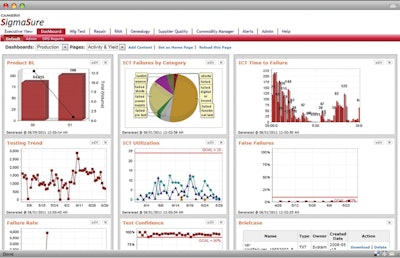
Takeaways:
- Manufacturers do not need to make significant IT investments to build a supply quality network.
- As brands and their quality have become increasingly outsourced, the traditional methods used to manage the supply chain have proven ineffective.
Product quality is the responsibility of all parties involved in the procurement, manufacturing, packaging, and distribution of raw materials, intermediates, and final products. Ultimately, the brand owner is responsible for assuring that all parties in the supply chain fulfill their responsibilities for delivering quality goods to the customer.
In today’s increasingly cutthroat global marketplace, particularly in the electronics sector, a number of trends are dramatically changing the supply base and challenging the ability of brand owners to manage their supply chains and ensure quality—effectively. Principal among these are greater reliance on component suppliers, outsourcing of subassemblies and offshore manufacturing.
Their impact has been to erode brand integrity, propagate downstream warranty issues, and complicate quality management. As brands and their quality have become increasingly outsourced, the traditional methods used to manage the supply chain have proven ineffective.
What’s more, access to data is unpredictable across the supply chain. The brand owner gets a number of reports, but they are often incomplete, in inconsistent formats, and after the fact. It is difficult to interpret the data and take effective action, and quality inevitably suffers.
Regaining Control
Historically, a number of approaches have been used to manage the supply chain and ensure quality. In the “trust” approach, manufacturers provided a specification and had faith that their suppliers would meet it. This proved unrealistic, creating another place for the phrase, “trust but verify.”
The need for verification resulted in inspections, where the brand owner’s quality engineering teams traveled to suppliers. While costly and exhausting, this met with some success; but over time—and in increasingly far flung locations—it proved that quality was fine when the quality engineering team was on site, but degradation often occurred after they left. Author Paul Midler has termed this phenomenon “quality fade.”
This experience underscored the need for quality trend analysis. An individual “quality snapshot” may be fine, but what became essential was continuous monitoring of quality, assuring that specs were met with exactitude and no corners were cut.
Some organizations developed extensive internal quality monitoring, from incoming inspection teams that retest supplied components to expensive proprietary monitoring systems that could cost tens of millions of dollars to develop.
All these methods have proved less than satisfactory, but the advent of cloud computing has provided a powerful new means to regain control. It has enabled the implementation of supply quality networks that provide continuous supplier performance monitoring, automatic data collection embedded in test equipment or from simple data entry at a supplier’s test station, automatic notification for lot acceptance, and lot rejection if minimum standards are not met.
Implementing a Better Solution
Applying a cloud-based solution to establish a supply quality network entails the execution of four basic steps:
1) Capture the data.
Some suppliers have automated production equipment and may even be using manufacturing execution systems. Some operate manually. Most companies have data in Excel that can be captured. If they are using pen and paper, then Web-based forms that are available in their native language are a big improvement and can improve the accuracy of the data.
2) Upload the data.
Captured data is aggregated, synchronized, and retained. The incoming formats are standardized and stored on servers where the supplier and the brand owner have secure access to viewing it. A quality issue will be visible immediately – before shipment.
3) Analyze the data.
Analytics must be applied to gain insight into quality issues and provide the ability to act on real-time and historical data immediately. Compare trends over time to isolate and preemptively address critical-to-quality issues.
4) Provide insight from the data.
The source of a problem can be elusive. An intelligent, multidimensional pattern recognition tool identifies the data clusters where anomalies and issues are, as well areas that do not require attention. Because of the sheer volume of data, this insight saves time and money while preventing problems.
The beauty of cloud-based solutions is that manufacturers do not need to make significant IT investments to build a supply quality network. Such a solution has value beyond product quality per se. Brand owners need second and third sources in case a key component supplier goes down. (Consider, for example, the effect of the recent Japanese earthquake and tsunami.) You can quickly bring alternate manufacturers online and monitor their product quality, ensuring the results you need and minimizing the impact to delivery schedules. A cloud-based solution can support a highly complex supply chain, including, for example, disparate locations in China and India, with a single solution.
Allaying Concerns
Brand owners and suppliers have related but different concerns regarding supply chain issues. Brand owners consider time to market, cost, and quality. Time to market pressure is huge, based on the sheer pace of innovation (changes to new phones or computer tablets), or based on specific market windows, such as holidays. Costs are affected by supplier costs, yields, rework and inventory levels, and are affected by efficiencies and product quality. Quality translates into brand protection on a high level, and warranty costs on a hard level. In 2010, the warranty accruals reported by all U.S.-based warranty providers grew to $22.7 billion, while the claims paid was $23.4 billion. For example, according to a Reuters report, Research in Motion recently had to recall 1,000 Playbook tablets. Supplier quality performance affects all three of these pressure points, thus the need to better manage them across the supply chain.
Suppliers may be concerned about participating in a supply quality network for several reasons. The first is the fear that the brand owner could use supplier data as pricing leverage. The supplier is already working on a very thin margin, and will not participate under threat of penalty. Secondly, test processes and product performance are highly proprietary. The supplier needs assurance that the competition does not have access to how his device is being tested, how fast it runs, and how long it takes to boot, etc.
The way to overcome these concerns is to see quality as a holistic issue. It's not just “my” quality versus “your” quality. If supplier quality improves and the brand owner increases market share, then the brand owner will use the quality supplier as a preferred vendor and buy more units from the supplier. Both the brand owner and the supplier win.
The brand owner also can show how high quality will help the supplier reduce scrap, reduce rework, and so reduce costs. A tool like this helps the supplier to be more efficient, and that translates into cost savings and higher output using the same resources.
Ongoing Benefits
For brand owners, the benefits of employing a cloud-based supplier quality network are significant. They include:
- Driving down costs
Actively manage manufacturing operations and quickly respond to out-of-compliance manufacturing process shifts and other events exposed through dashboard and alerts. - Increasing yields, minimizing rework and returns
Proactively leverage manufacturing and test data via a Web browser from anywhere in the world. Detect product problems at the source, prior to shipment, to prevent quality escapes. This is “pushing quality back to the source.” - Proactively managing product quality
Automatically collect data from the test floor and redirect engineering from time-consuming data-gathering tasks to high-value problem solving. For example, one of the world’s leading global medical device companies is using a quality network’s real-time dashboards and alerts on test and quality metrics to support the maintenance of validated states on all products. - Accelerating continuous improvement initiatives and new product introductions
Roll up and analyze granular parametric and attribute test data associated with each serial number and subassembly, and correlate it with return and warranty analysis. - Reducing audits and incoming inspections
Replace contract manufacturer audits with real-time monitoring and replace incoming quality inspections with dock-to-stock deliveries. - Fortifying supplier relationships
Foster collaborative communication, planning, and problem resolution between suppliers, contract manufacturers, and your quality personnel. This leads to a significant reduction in defects and related costs.
For suppliers, the benefits of participating in a supplier quality network include:
- Meeting customer requirements for Certificates of Compliance (CoC) —electronically and instantly
- Increasing factory productivity and output while improving quality
- Seeing and correcting embarrassing issues before shipment and customer complaints.
- Reducing disruptive on-site customer audits
- Eliminating paperwork
- Gaining preferred supplier status and higher ratings
- Lowering cost of quality with visibility into production trends
Many decades ago, W. Edward Demmings said that quality is everyone’s responsibility. When he uttered those words, the kind of supply chains we have today were not yet envisioned; but the words still apply. A holistic view of quality benefits all: supplier, manufacturer, and customer. Applying that perspective through cloud-based tools such as supplier quality networks is providing renewed control in these challenging times.
Nader Fathi is General Manager, Supply Chain Quality, at Camstar Systems, Inc.
Caption: Real-time dashboards and alerts on supplier test and quality metrics expose out-of-compliance manufacturing process shifts and other events, making it possible to resolve product quality issues at the source.















